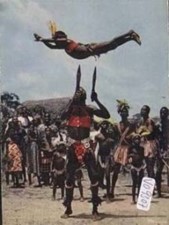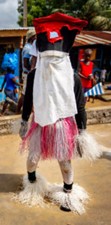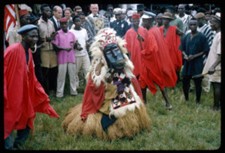
Happy Holidays!
The best part about my writing life is sharing most of my journeys. In my new children’s book, Christmas in Sanoyea, readers experience a little of the celebrations on Christmas day in Liberia. This Christmas, Ian is looking forward to spending the holiday with his twin cousins, Nostelor and Nostelda, who have come to Liberia from America for their first Christmas. But they won’t be spending Christmas in Monrovia, where the city is bursting with entertainment. On Grandpa’s farm, Christmas in Sanoyea would surely be unforgettable.
Christmas is the most celebrated holiday in Liberia. No matter what your family’s financial circumstances were, everyone got something new. Most children knew their parents gave them Christmas presents, not Santa Claus. Nevertheless, we looked forward to seeing Sanny Klos (Santa Claus) more than anything else.
The Christmas season begins with the appearance of the first Sanny Klos [more than one Sanny Klos comes through the neighborhood during the entire holiday season]. It might be a cool evening, early in December, when you barely hear the throbbing drums at a distance. Before long, to your delight, the small gathering of strangers eventually reaches your neighborhood—Sanny Klos appears with his entourage of musicians and a group of fans. He is skinny, custom-dressed with sequence trimmings down the side of his pants, his long-sleeved shirt, gloves to cover his hands, and a pleasant-to-look-at false face (face mask). The musicians are geared with different musical instruments: two or three types of drums, a carpenter’s saw, a few empty Club Beer bottles, an old wooden washboard, and other objects suitable to make noise. These musicians pound the drums, strike the edge of the saw with rhythm [using a knife], and run the spoon up and down the washboard repeatedly to make authentic music. Sanny Klos dances and performs all sorts of acrobatic turns to the rhythm of their music. He positions his body, lying face down with his hands under his shoulders as if he is about to do a push-up exercise, but trembles instead, so we are in awe of the dynamic actions of the tassels on the side of his pants and shirt sleeves. He skips, shuffles, swings, and prances with impressive dance routines.
Spectators pay nickels, dimes, quarters, and sometimes a dollar for their magnificent performances. I did not realize then that these were cultural artists earning a living.
I must confess, this entertainment gets addicting. Absent-mindedly, you are inclined to follow the group as they leave your neighborhood to perform in other neighborhoods. This show is so amusing that you are unaware of the distance you’ve traveled, following the entertainers from one neighborhood to another. Before you know it, you have gone several miles from home without your parent’s permission and risk getting some tough love.
You were not the only child out of your neighborhood, though; almost all the children from the neighborhood followed. We all got into trouble because of this. I always followed Sanny Klos and his group at least three neighborhoods away, beyond the places my parents did not allow me to go. But my parents did not always go tough-love on my little behind. They understood the temptation. Besides, I’m sure they, too, were tempted when they were kids.
Besides Sanny Klos, Oldman Beggar (another form of Sanny Klos) also comes along. We loved Oldman Beggar as much as we loved Sanny Klos. Oldman Beggar has a protruding belly, is dressed in ragged clothes, and wears a more comical false face. Oldman Beggar does not give you the same performances as Sanny Klos. He or she does, as the name pertains, begs. He has a much smaller entourage, perhaps two to three persons, including Oldman Beggar. The drummer, who might also be the spokesperson, tells a tale of Oldman Beggar’s misfortune trip.
“While carrying a canoe full of toys, it capsized,” he tells the audience, “Oldman Beggar lost the children’s Christmas gifts and personal belongings. Distressed over this, Oldman Beggar has to beg for money to replace his lost things.”
Spectators have heard that story many times before, yet they respond as if it were being told for the first time. Everyone is also familiar with the only song Oldman Beggar sings and would join the musicians as they sang.
Oldman Beggar wobbled his potbelly playfully and sometimes fell on the ground, making everyone laugh. Spectators paid nickels, dimes, and quarters as they did Sanny Klos.
Other groups toured the neighborhoods to perform their acts. These are seasonal employment opportunities for a lot of folks. We watched in wonderment at the tumbling dances of the Snake Baby (acrobatic dancers, mainly girls ages 5 to 15). Wearing grass skirts only, their bodies were artfully painted with white chalk. These skilled acrobats performed complicated and intricate tricks, requiring great skill and agility. They tumbled and jumped, then flawlessly landed on one leg on the arm or shoulder of their master. At times, they balanced their midsection on a pointed knife that he held under their suspended body. Miraculously, there would be no sight of blood. I don’t believe they would be stabbed, and it was an incredible illusion. The Snake Baby dancers also got paid for their performances, like Sanny Klos and Oldman Beggar were.
Watching these performances was like being entertained at a Broadway theater but in your backyard.
Oldman Beggar! John the Beggar!
Beg for Money! John the Beggar!
Beg for five cents! John the Beggar!
Beg for ten cents! John the Beggar!



